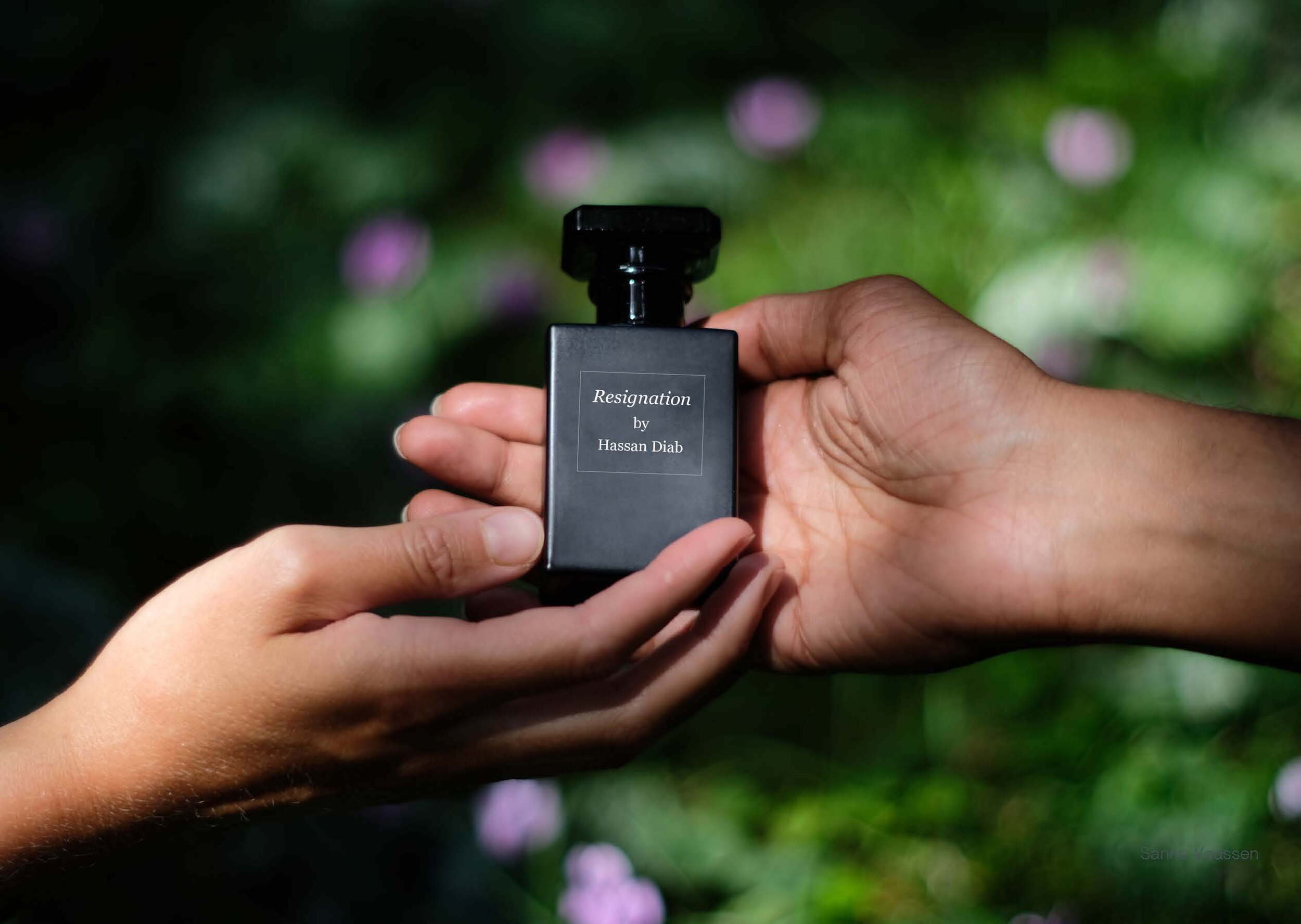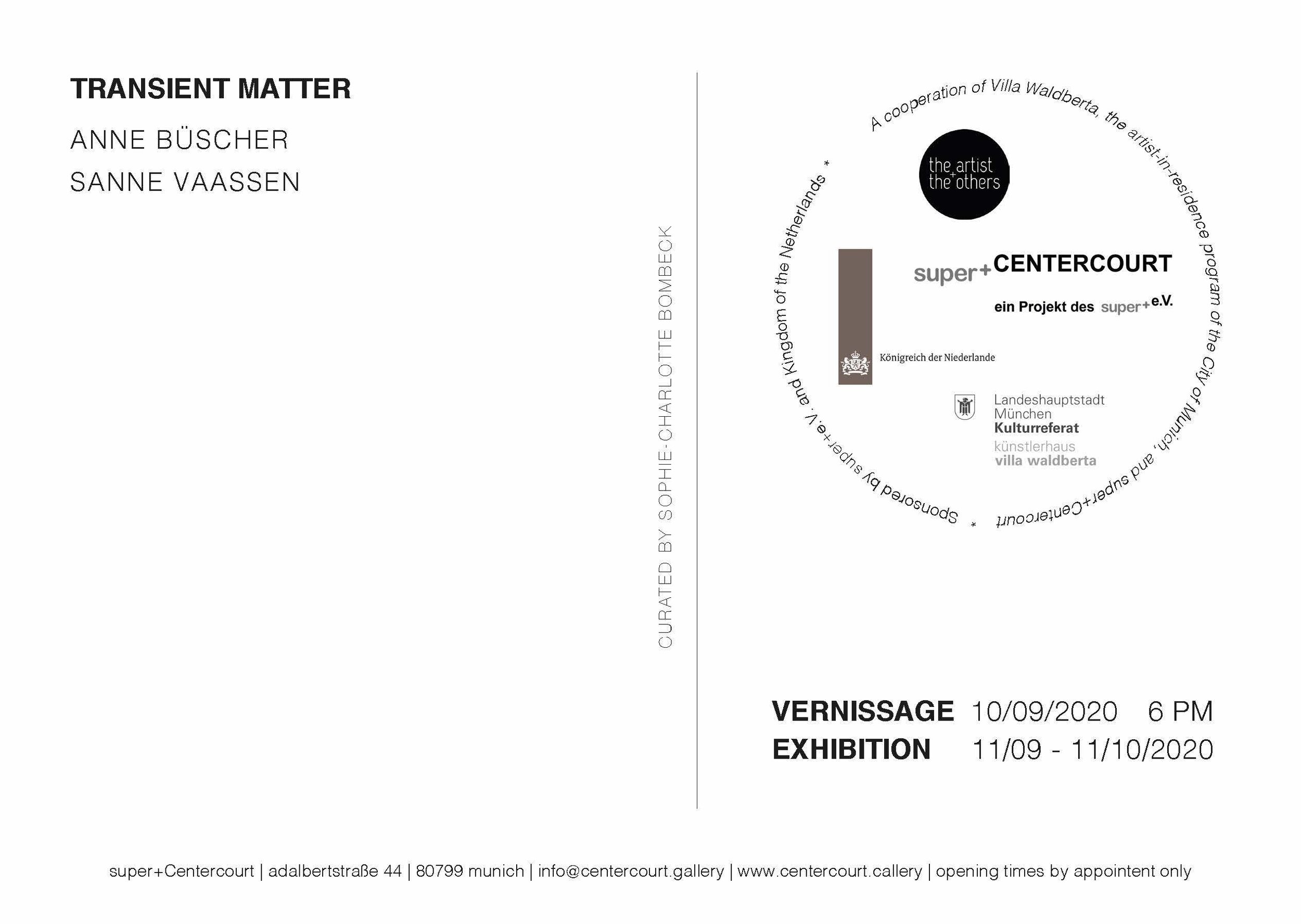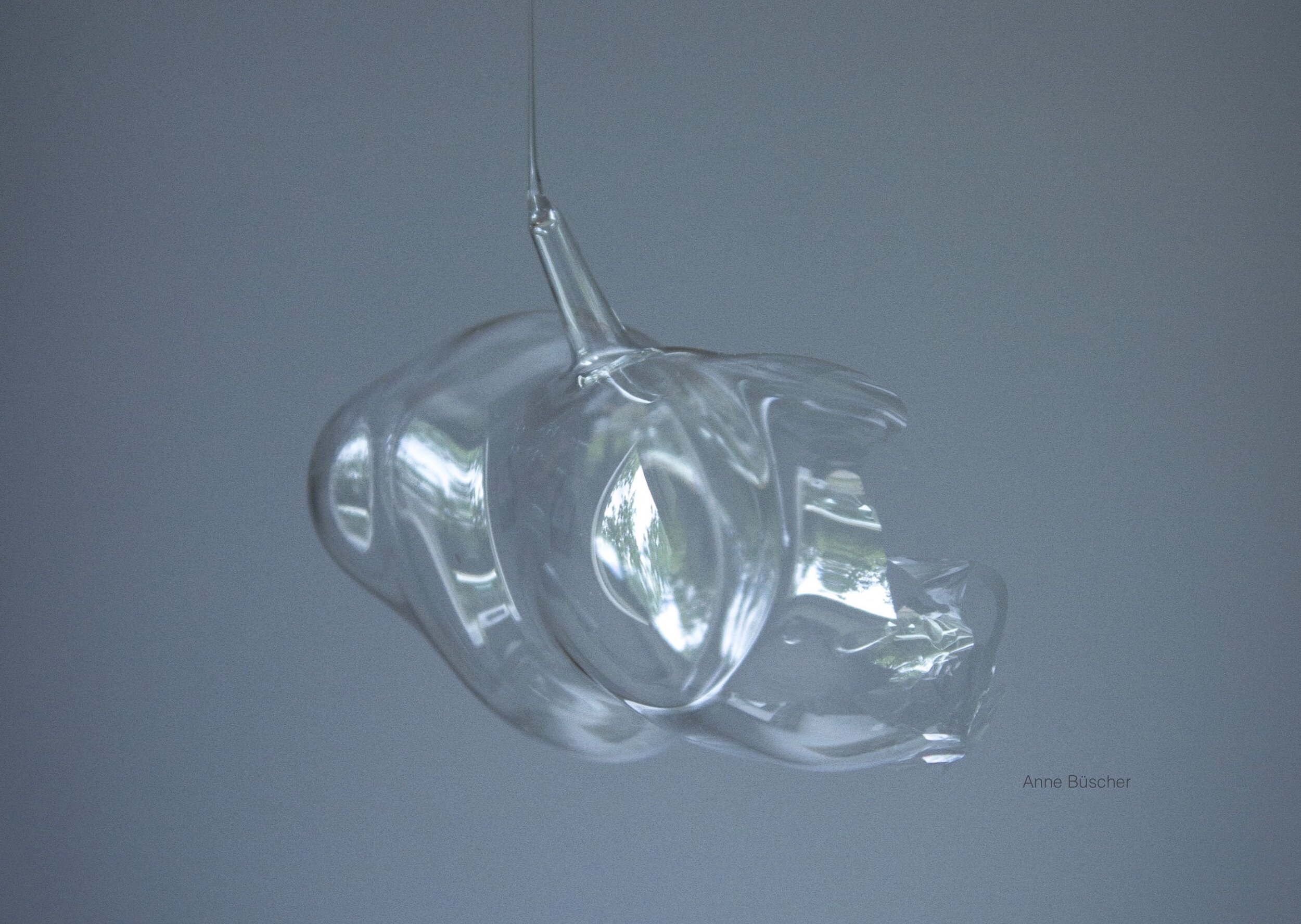Vernissage 10/9/2020 Exhibition 11/09/ – 25/10/2020
EN
The exhibition "Transient Matter" presents the two artists Anne Büscher and Sanne Vaassen from the Netherlands for the first time in the super+Centercourt. The project is a cooperation between Villa Waldberta, the Artist-in-Residence Program of the City of Munich, the exhibition space super+Centercourt and the Dutch foundation "The Artists and the others".
The exhibition deals with the transience and momentum of matter. Matter is no longer understood only as a carrier of form and idea, but emphasizes its epistemic but also cultural significance for the present or examines its semantic and historical relevance. For both artists, contact with nature is crucial, with the artists acting as alchemists, whereby their works are an expression of artistic research. By investigating, analyzing and documenting natural phenomena, they create compositions between chance and control. While Anne Büscher works with various materials such as glass, marble, ceramics, photography, silicon, stone or immaterial energetic and at the same time volatile substances such as light and air and explores them in her artistic work. Sanne Vaassen investigates the relationship between material, object and language. The artist materializes ephemeral conversations, memories, time and their interrelations with real references to the history and immediate events of our time, opening up to the viewer forgotten traditions as well as new perspectives on social and societal phenomena.
In the super+Centercourt the two artists present their works together, the materials they use are witnesses of their stay in the Villa Waldberta. Findings and objects from the immediate surroundings of the Bavarian lake district or abstracted forms of language as a momentary impression confront us. Together they escaped forms and ways of presentation, between object and exhibition furniture the works intertwine and act on the place as exhibition space itself. The connecting elements of the exhibition are the brownish, yellow to ochre coloured floor and the marble stucco plinths that support and present the works. The artists use a technique that is almost forgotten in the stucco craft. The painting of the marbling and the colouring of the floor is based on a mixture of clay powder from the Ammersee and sand from the Starnberger Lake. The connecting moment becomes the base of the exhibition and picks up the transient, temporary medium, which is also reflected in the respective works of the artists.
Anne Büscher shows the viewer* the lightness, flexibility but also fragility of the medium glass. The glass mobiles or hanging sculptures protrude from the ceiling. Filigree silver bubbles are connected with threads of pure silk that level out until they float in perfect balance. Gentle air currents cause the mobile to oscillate again from time to time, modifying the arrangement of the object. Both artists make the properties of air their own. While Anne Büscher makes use of the technical properties in the form of movement and in the interaction within the production of the individual mouth-blown glass objects, Sanne Vaassen works with the aesthetic effect of matter in which a mixture of alcohol and natural essences dissolved in it are distributed through the air. The inverse matrix, the invisible, takes shape, a kind of alchemical keynote that allows intellect, emotion and senses to become the activating potential in and of the work. Not only is the visionary inherent in the new materialistic tendencies, but rather an analysis of the present, the reflection of the past and a speculative approach to the future.
The round clay cups on the floor refer to what is ahead, they are an intermediate result, a momentary impression and give an insight into Anne Büscher's artistic research. The self-purified clay from the Ammersee is also used here. They are first investigations on the origin of the material, studies on the properties, colour and texture.
As a place of contemplation, as an archive of our memories, Sanne Vaassen creates an encyclopedia of the flowers she finds in the garden of Villa Waldberta, transcribing the flower symbolism from flower to word or from word to flower. Today, the language of flowers has been somewhat forgotten, but flowers were once the code for what one wanted to say or ask but did not dare to say. Thus, as early as the middle of the 18th century, a system of signs emerged that is almost as multifaceted as a foreign language. (The book itself, however, is not part of the exhibition and can be viewed in another exhibition at Villa Waldberta in October).
In her work, the artist draws on the communication system of flowers and creates three perfumes based on three different addresses by Angela Merkel (Chancellor of the Federal Republic of Germany), Hassan Diab (the recently retired Prime Minister of Lebanon) and Narendra Modi (acting Prime Minister of India). A perfume in the strict sense is a fragrance composition that serves the personal well-being of a person and its presentation to others. The use of aromatic substances was considered a source of inspiration and was already in the ancient advanced civilizations of Egypt and India in the use of craft tradition, spirituality and medicine. They were understood as an expression of the pictorially aesthetic beauty ideals of their time. Thus the artist uses the speeches of the individual speakers as a kind of recipe and transcribes the words, depending on their frequency, into an instruction for the fragrance compositions. In this way the visitors* get an olfactory impression of the individual speakers and their words. An expression of a social-political aesthetic society? As the French philosopher Michel Onfray wrote in 1999 in "The Forms of Time": "In a world that is entirely devoted to the delights of the chronometer and industry, the garden is a kingdom of peace and balance, a kingdom of harmony and tranquility. ... It is always an enclave of an ironic time, a time of peace, which is included like an outgrowth in the tragic time.
The scent of the German Chancellor Angela Merkel is based on the speech about the corona spread in the Tagesschau on 18.03.2020. Hassan Diab's scent is a transcription of his speech of 10.08.2020 in which the Lebanese Prime Minister announces the resignation of the government after the explosion in Beirut. The third perfume is a transcription of the speech of Prime Minister Narendra Modi who, on July 3, 2020, speaks to the Indian troops in Ladakh, the disputed Himalayan region in which China and India have been fighting for supremacy in Central Asia and its borders since 1962.
The work "Weathering Language" drones in the background of the exhibition. It plays old language learning LP's on a turntable. Stones are placed on and around the record, they create tracks, cuts and scratches that distort the voices and influence the intelligibility. The mixing, stagnation, growth or contraction of language is the theme of this work. The artist herself refers to the formation of stones and draws a comparison to the external factors that influence and change language.
The formation of stones begins with the weathering or the disintegration of the exposed rock into small fragments. Through the process of erosion, these fragments are removed from their source and transported to a new location by wind, water, ice or biological activity. Once the sediment settles somewhere and accumulates enough of it, the lowest layers are compacted so firmly that they form solid stones. The continuity of change leads the artist to draw a parallel between stones and language. The second is continuously evolving by mixing or stagnating, growing or contracting. The artist investigates the extrinsic and intrinsic factors of language change and observes trans-culturally intertwined migratory movements as well as social and media aspects as essential driving forces.
In her work Sanne Vaassen investigates social structures, dynamics and cultures, whereby the artist repeatedly takes up constructed compositions of established symbols and traditions.
PRACTICAL MAGIC – VILLA WALDBERTA
_________________________
A cooperation of Villa Waldberta, the artist-in-residence program of the City of Munich, and super+Centercourt and the Dutch foundation "The Artists and the others".
Supported by the Dutch Consulate and super+e.V.
_________________________
Anne Büscher* 1991 in Stuttgart, lives and works in Maastricht. From 2014 she studied jewellery design at the Maastricht Academy of Fine Arts and Design and graduated in 2017 with a master's degree in "Materialization in Art and Design" at the Sandberg Instituut Amsterdam. She works as an artist, curator and guest lecturer at various educational institutions in the Netherlands. And has already made several artist residencies, including Tokyo Wonder Site in Tokyo, Japan, Ravi Liège, the Glass Factory (Sweden).
Sanne Vaassen *1991 in Maastricht, lives and works in Maastricht. She completed her Bachelor's degree at the Maastricht Academy of Fine Arts and Design in 2013 and worked at the Jan van Eyck Academy in 2014/2015. She received the Emerging Artist Grant in 2015 and the Established Artist Grant from the Mondriaan Fund in 2019. She was nominated for the Sybren Hellinga Prize in 2016, the Parkstad Limburg Prize in 2016 and the OPEN Prize in 2020, organised by De Balie and Amsterdam's 4 en 5 mei comité. Her work has been exhibited in Maastricht, Eindhoven, De Pont, Tilburg, Dubai, New York and London, among others.
DE
Die Ausstellung „Transient Matter“ präsentiert erstmals im super+Centercourt die zwei Künstlerinnen Anne Büscher und Sanne Vaassen aus den Niederlanden. Das Projekt ist eine Kooperation zwischen der Villa Waldberta, dem Artist-in-Residence-Programm der Stadt München, dem Ausstellungsraum super+Centercourt sowie der niederländischen Stiftung „The Artists and the others“.
Die Ausstellung beschäftigt sich mit der Vergänglichkeit und Eigendynamik von Materie. Dabei wird Materie nicht mehr nur als Träger von Form und Idee verstanden, sondern betont, ihre epistemische aber auch kulturelle Bedeutung für die Gegenwart oder untersucht ihre semantische und historische Relevanz. Für beide Künstlerinnen ist der Kontakt zur Natur ausschlaggebend, dabei agieren sie als Alchimistinnen, wobei ihre Werke Ausdruck künstlerischer Forschung sind. Durch das Untersuchen, Analysieren und Dokumentieren von natürlichen Phänomenen schaffen sie Kompositionen zwischen Zufall und Kontrolle. Während Anne Büscher mit verschiedenen Materialien wie Glas, Marmor, Keramik, Silizium, Stein oder mit immateriellen energetischen und zugleich flüchtigen Substanzen wie Licht und Luft arbeitet und in ihrer künstlerischen Arbeit erforscht, untersucht Sanne Vaassen das Verhältnis von Material, Objekt und Sprache. Die Künstlerin materialisiert dabei ephemere Gespräche, Erinnerungen, Zeit und ihre Wechselbeziehungen mit realen Bezügen zur Historie und unmittelbaren Geschehnissen unserer Zeit. Sie eröffnet dabei den Betrachter*innen in Vergessenheit geratene Traditionen sowie neue Perspektiven auf soziale und gesellschaftliche Phänomene.
Im super+Centercourt präsentieren die Künstlerinnen ihre Arbeiten gemeinsam, wobei die genutzten Materialien Zeugen ihres Aufenthalts in der Villa Waldberta sind. Fundstücke und Objekte aus der unmittelbaren Umgebung der bayrischen Seenlandschaft oder aber abstrahierte Formen von Sprache als Momentaufnahme treten den Betrachter*innen entgegen. Gemeinsam entwickelten die Künstlerinnen dabei Formen und Wege der Präsentation; zwischen Objekt und Ausstellungsmobiliar greifen die Werke ineinander über und reagieren auf den Ort als Ausstellungsraum selbst. Als Verbindungsmoment der Ausstellung dient dabei der bräunlich, gelbe bis ocker eingefärbte Boden sowie die Sockel aus Stuckmarmor, die die Arbeiten stützen und präsentieren. Bei der Herstellung bedienen sich die Künstlerinnen gemeinsam einer Technik, die im Stuckhandwerk kaum noch geläufig ist: Die Aufmalung der Marmorierung sowie die Einfärbung des Bodens basiert auf einem Gemisch mit Tonpuder aus dem Ammersee sowie Sand aus dem Starnberger See. Der verbindende Moment wird hier zum Träger der Ausstellung und greift das transiente, vorübergehende Medium, welches auch in den jeweiligen Werken der Künstlerinnen verdeutlicht wird, wieder auf.
Die runden Tonbecher von Anne Büscher auf dem Boden verweisen auf das was noch vor uns liegt, sie sind ein Zwischenergebnis, eine Momentaufnahme und geben einen Einblick in die künstlerische Forschung. Auch hier findet der selbst gereinigte Ton aus dem Ammersee Verwendung. Es sind erste Untersuchungen über Herkunft des Materials, Studien zu den Eigenschaften, der Farbe und Textur.
Anne Büscher führt den Betrachter*innen die Leichtigkeit, Flexibilität aber auch Zerbrechlichkeit des Mediums Glas vor Augen. Die Glasmobiles oder Skulpturen ragen von der Decke. Es sind filigrane silberne Blasen verbunden mit Fäden aus reiner Seide, die sich nivellieren, bis sie in einem perfekten Gleichgewicht schweben. Sanfte Luftströmungen bringen das Mobile dabei immer wieder ins Schwanken und verändert dabei die Anordnung des Objekts. Beide Künstlerinnen machen sich die Eigenschaften der Materie Luft zu eigen. Während Anne Büscher sich die technischen Eigenschaften zu nutzen macht, in Form von Bewegung und im Zusammenspiel innerhalb der Produktion der einzelnen mundgeblasenen Glas-Objekte, arbeitet Sanne Vaassen mit der ästhetischen Wirkung der Materie in der sich ein Gemisch von Alkohol und darin gelöste natürliche Essenzen durch die Luft verteilt. Die inverse Matrix, das Unsichtbare nimmt Gestalt an, eine Art alchemistischer Grundton der Intellekt, Emotion und Sinne zum aktivierenden Potenzial im und zum Werk werden kann. Dabei ist nicht nur das Visionäre den neuen materialistischen Tendenzen inhärent, sondern vielmehr eine Analyse der Gegenwart, die Reflexion der Vergangenheit sowie ein spekulativer Ansatz im Hinblick auf die Zukunft.
Als Ort der Kontemplation, als Archiv unserer Erinnerungen schafft Sanne Vaassen ein Lexikon der Blüten, die sie im Garten der Villa Waldberta vorfand. Sie transkribiert dabei die Blumensymbolik von Blume zum Wort oder vom Wort zur Blume. Heute ist die Sprache der Blumen etwas in Vergessenheit geraten, doch waren Blumen einst der Code für das, was man sagen oder fragen wollte, aber nicht auszusprechen wagte. So entstand bereits Mitte des 18. Jahrhunderts ein Zeichensystem, welches fast so facettenreich war wie eine eigene Sprache. (Das Buch selbst ist jedoch nicht Teil der Ausstellung und kann im Oktober in einer weiteren Ausstellung in der Villa Waldberta begutachtet werden.)
Die Künstlerin greift in ihrer Arbeit auf das Kommunikationssystem der Blumen zurück und kreiert auf der Basis von drei unterschiedlichen Ansprachen von Angela Merkel (Bundeskanzlerin der Bundesrepublik Deutschland), Hassan Diab (der kürzlich zurückgehende Ministerpräsident des Libanon) und Narendra Modi (amtierender Premierminister Indiens) drei Parfums. Ein Parfum ist im engeren Sinn eine Duftkomposition die dem persönlichen Wohlbefinden eines Menschen und seiner Darstellung gegenüber anderen dient. Die Einsatzmöglichkeiten von aromatischen Substanzen galten als Quelle der Inspirationen und waren bereits in den alten Hochkulturen Ägypten und Indien im Einsatz der Handwerkstradition, Spiritualität und Medizin. Sie wurden als Ausdruck bildästhetischer Schönheitsideale seiner Zeit verstanden. So nutzt die Künstlerin die Reden der einzelnen Sprecher als eine Art Rezept und transkribiert die Wörter je nach Häufigkeit in eine Anleitung für die Duftkompositionen. So bekommen die Besucher*innen einen olfaktorischen Eindruck der einzelnen Sprecher und ihrer Worte. Ein Ausdruck einer sozialpolitik ästhetischen Gesellschaft? Der französische Philosoph Michel Onfray schreibt 1999: „In einer Welt, die sich ganz und gar den Wonnen des Chronometers und der Industrie ergibt, ist der Garten ein Reich des Friedens und der Ausgeglichenheit, ein Reich der Harmonie und der Ruhe. … Stets ist er eine Enklave einer ironischen Zeit, einer Zeit des Friedens, die wie ein Auswuchs in die tragische Zeit mit eingeschlossen ist.“ (siehe: „Die Formen der Zeit“).
Der Duft der deutschen Bundeskanzlerin Angela Merkel basiert auf der Ansprache zur Corona-Ausbreitung in der Tagesschau am 18.03.2020. Hassan Diab’s Duft ist eine Transkription seiner Ansprache vom 10.08.2020 in welcher der libanesische Premierminister nach der Explosion in Beirut den Rücktritt der Regierung ankündigt. Das dritte Parfüm ist ein Zeugnis der Ansprache des Premierministers Narendra Modi der am 03.07.2020 zu den indischen Truppen in Ladakh, der umstrittenen Himalaya-Region in der China und Indien seit 1962 um die Vormachtstellung in Zentralasien und ihre Grenzen kämpfen spricht.
Die Arbeit „Verwitterungssprache“ dröhnt im Hintergrund der Ausstellung. Sie spielt alte Sprach-lern LP’s auf einem Schallplattenspieler ab. Steine liegen dabei auf und um die Schallplatte herum, sie erzeugen Spuren, Schnitte und Kratzer, die die Stimmen verzerren und die Verständlichkeit beeinflusst. Dabei ist das Vermischen, Stagnieren, Wachsen oder Zusammenziehen von Sprache Thema dieser Arbeit. Die Künstlerin selbst verweist auf die Entstehung von Steinen und zieht einen Vergleich zu den äußerlichen Faktoren die Sprache beeinflusst und verändert.
Die Bildung von Steinen beginnt mit der Verwitterung oder dem Zerfall des freigelegten Gesteins in kleine Fragmente. Durch den Prozess der Erosion werden diese Fragmente von ihrer Quelle entfernt und durch Wind, Wasser, Eis oder biologische Aktivität an einen neuen Ort transportiert. Sobald sich das Sediment irgendwo absetzt und sich genug davon ansammelt, werden die untersten Schichten so fest verdichtet, dass sie feste Steine bilden. Die Kontinuität der Veränderung bring die Künstlerin dazu eine parallele zwischen Steinen und Sprache zu ziehen. Wobei sich letztere kontinuierlich entwickelt, indem sie sich vermischt oder stagniert, wächst oder sich zusammenzieht. Die Künstlerin fragt dabei nach den extrinsischen sowie intrinsischen Faktoren des Sprachwandels und beobachtet als wesentliche Triebkräfte transkulturell verflochtene Migrationsbewegungen aber auch Aspekte des Sozialen und Medialen.
In ihren Arbeiten untersucht Sanne Vaassen gesellschaftliche Strukturen, Dynamiken und Kulturen, wobei die Künstlerin immer wieder konstruierte Kompositionen von etablierten Symbolen und Traditionen aufgreift.
Eine Kooperation von Villa Waldberta, dem Artist-in-Residence-Programm der Landeshauptstadt München und super+Centercourt und die niederländische Stiftung "The Artists and the others".
Gesponsert durch das Königreich der Niederlande & der super+e.V
_________________________
Anne Büscher* 1991 in Stuttgart, lebt und arbeitet in Maastricht. Sie studiert ab 2014 Schmuckdesign an der Maastricht Academy of Fine Arts and Design und macht 2017 ihren Masterabschluss in „Materialization in Art and Design“ am Sandberg Instituut Amsterdam. Sie arbeitetet als Künstlerin, Kuratorin und Gastdozentin an unterschiedlichen Bildungseinrichtungen in den Niederlanden. Und hat bereits einige Künstlerresidenzen gemacht, darunter in Tokyo Wonder Site in Tokyo, Japan, Ravi Liège, the Glass Factory (Schweden).
Sanne Vaassen *1991 in Maastricht, lebt und arbeitet in Maastricht. Sie schloss 2013 ihr Bachelorstudium an der Maastricht Academy of Fine Arts and Design ab und war 2014/2015 an der Jan van Eyck-Akademie tätig. Sie erhielt 2015 das Stipendium Emerging Artist und 2019 das Stipendium Established Artist des Mondriaanfonds. Sie wurde 2016 für den Sybren-Hellinga-Preis, 2016 für den Parkstad-Limburg-Preis und 2020 für den von De Balie und Amsterdams 4 en 5 mei comité organisierten Preis OPEN nominiert. Ihre Arbeiten wurden u.a. in Maastricht, Eindhoven, De Pont, Tilburg, Dubai, New York und London ausgestellt.





